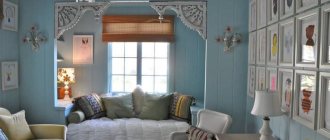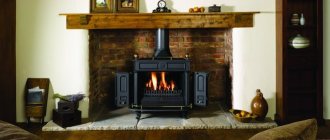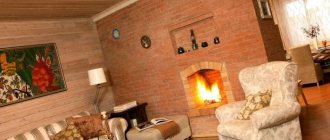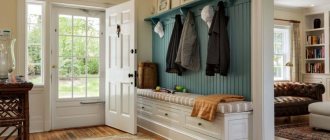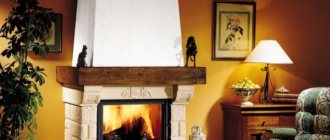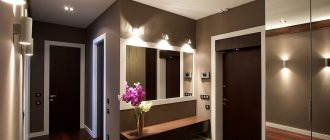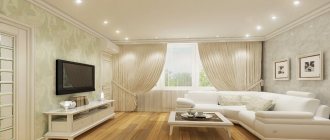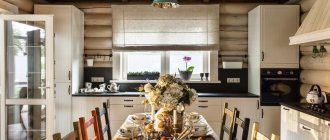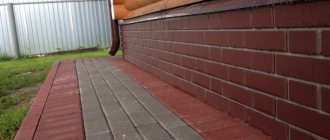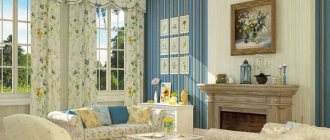Each of us loves to go to our country house on the weekend, escape from the bustle of the city, relax and unwind. But it’s difficult to imagine a proper rest without lighting.
Light is one of the most important elements in the house; without it, any task will turn into a whole ordeal. It also ensures safety while moving around the house or outside its territory at night.
Currently, manufacturers offer a variety of options for lamps, chandeliers, llamas and other lighting sources for a private home.
Home interior lighting
First of all, the lighting inside the house itself must be safe for residents. It is also worth contacting specialists and drawing up the correct and competent lighting scheme for higher efficiency.
- Basic principles when placing light sources inside the house.
- Location of lamps and other devices in rooms.
- Places for control devices. Switches can be mechanical or more complex designs.
- Places for placing electrical appliance networks.
There are a number of standard lighting schemes for certain types of houses, but highly qualified specialists can develop an individual scheme specifically for your building.
Many people like to highlight different details in their home. Such details are stairs, various shelves and tables.
A great way to highlight a detail is to highlight it. For example, you can install many spotlights on the inside of your flight of stairs, and you can also install the same spotlights in cabinets with glass doors.
When creating a lighting scheme, you can show your imagination and create a unique design and atmosphere.
Lighting in the house is divided into diffused, directional and combined.
The directional light is sharp, clearly expressing various details and shadows on the subject. Diffused lighting evenly illuminates the subject, making it difficult to see shadows on it.
Combined light is an even combination of the two types of lighting listed above.
Lighting for living room and kitchen
Both the kitchen and living room are active rooms and are multifunctional. Lighting for the active areas of the house is developed to the maximum, and is provided for at the earliest stages of designing a house - when choosing the orientation of the main rooms according to the cardinal points.
The best options for natural lighting are the orientation of the room to the south and east; this part of the house is usually reserved for the children's room, living room and kitchen. Summer dining shading is done depending on the level of insolation. Evening electric lighting should in any case be uniform and warm.
In country houses, the kitchen is a very special room, and modern layouts position the kitchen as a combined dining room and even a living room - family gatherings and receiving guests are convenient and justified in an active kitchen area with free space and good lighting. Proper lighting of such a multifunctional kitchen-dining room requires the organization of several lighting scenarios.
For receiving guests or a festive family dinner, organizing lighting requires a special approach, depending on the size and style of the existing room.
Modern pendant chandeliers of large sizes are appropriate in living rooms, and for intimate gatherings in the evening, the best option would be soft diffused and directional lighting with floor lamps and wall sconces; fabric lampshades and environmentally friendly lamps made of wood and textiles are in perfect harmony with quiet evenings.
The fireplace area of the living room also requires lighting, usually symmetrical - each side of the fireplace shelf is illuminated by a separate wall sconce, corner fireplaces are emphasized by floor lamps that provide dim directional light.
Light in recreation areas
For relaxation in any apartment or house there are separate, special zones, and the lighting of these zones should be soft, promoting relaxation - this could be a floor lamp, a floor lamp or a suspended ceiling light with a “floating ceiling” design. Soft and cozy curtain lighting can be combined with floor lamps, sconces and ceiling lamps to create constant light.
For the bedroom, bedside areas are illuminated with symmetrically located sconces or table lamps with diffuser shades; usually these additional light sources are used for reading. For general lighting, pendant chandeliers, built-in ones, or LED lighting in tiered structures are used - the main choice is the personal preferences of the owners. One of the reasons for organizing general lighting is to reduce sudden changes in light brightness.
Lighting of stairs, hallways, lobbies, corridors
For the hallway, bright lighting is very important, since this room is the first to tell both the house and the owners, and should create the most favorable impression. Provided it is bright, the light should not cause visual discomfort when entering the hallway, but nevertheless be strong enough for comfort when gathering at the mirror before leaving the house.
Wall sconces are very appropriate in hallways, as in any part of the house - these lamps are very functional. Traditionally, sconces illuminate areas of rooms with mirrors and interior elements that people want to draw attention to.
A long corridor is perfectly illuminated by a number of single-plane lighting fixtures placed at the same height or in a given sequence. A visual narrowing of space occurs only when wall lamps are installed in one high-rise level symmetrically to the axis of a long corridor; one row, on the contrary, creates a slight effect of additional space.
Stairs must be illuminated; lighting of stairs is a requirement for safe operation. For stairs, diffused light lighting fixtures and lamps that provide low brightness are used; for LEDs this is only 3 W.
Special lighting for staircases with markers is modern and economical, and in terms of design it is a logical solution for creating an effect that can transform the entire lobby area. Markers today are considered to be the most advanced equipment for home lighting, and they provide enormous design possibilities - realistic imitations of natural scenes or simple flashlights, any choice will be successful.
The markers are designed specifically for illuminating stair steps and a small space around them; blinding a person on the stairs is impossible, since the light flux is strictly directed. Moreover, the power is quite low, which has a positive effect on savings.
What lamps can be used?
To illuminate the interior space of a country house, you can use:
- Incandescent lamps are a classic option that we have known for quite a long time. Of course, they do not have a negative effect on human eyes and create a pleasant luminous flux, but due to the high thermal output (the efficiency is less than 10%), they are used less and less.
- Fluorescent lamps are light sources that emit a bluish-white light, which not everyone likes. They do not give off heat, but they create an unpleasant and irritating sound. Fortunately, modern models have practically eliminated these shortcomings.
- Halogen and metal halide light sources are lamps that emit directional beams, so they can be used to illuminate decorative elements (paintings, columns, etc.).
- LEDs are a popular type of lamp because they do not emit harmful emissions. In addition, LEDs are strong and durable, have good light output and do not heat up the surrounding area.
- Light cords (duralight) are light sources related to LEDs, which are used for decoration (lighting individual interior elements).
What types of lamps are there for outdoor lighting?
There are no fewer lamps for street lighting than lamps for the home. The most commonly used external soffits are:
- spotlights (mounted on walls to illuminate architectural elements of the house and yard);
- pendant lamps;
- lanterns on poles;
- landscape ground soffits with short legs;
- Wall lights;
- LED strips.
The style of exterior lamps can be anything, but it must correspond to the general mood and trends - echo the style of landscape design and architectural elements. It is logical that for a garden decorated in the romantic Provence style, soffits with curls, made of hardened metal covered with a noble patina, are selected. And the ultra-modern landscape will be decorated with minimalist chrome lamps in high-tech style.
Tips for organizing street lighting
To ensure that outdoor lighting at home pleases with its decorative effect and, importantly, is safe, special attention is paid to its moisture resistance and insulation. For example, it is better to lay wiring for outdoor lamps underground, so that intertwining wires will not spoil the appearance of the landscape and will be protected from mechanical damage.
Do not strive for 100% illumination of the area; in the evening, light twilight is still more familiar and romantic than flooding light, as in a room. In addition, street lighting for a country house is perceived easier and more comfortable for vision if lamps with warm, yellowish light are used to organize it; it is this light that best sets off the greenery and emphasizes the architecture of buildings.
There are some more useful tips for those who organize yard lighting with their own hands:
- When installing lamps, place them symmetrically or install them in such a way that the light rays intersect - this way the lighting will be full and voluminous.
- Pay attention to the dust and moisture resistance of the lamps; this indicator is expressed by the IP index and should be at least IP44.
- Take into account the climatic features of your region; in some cases, it is advisable to dismantle the lamps for the winter period or additionally insulate them - “preserve them”.
- When installing lamp posts, it is recommended to secure them with cement mortar so that they do not tilt during operation.
- Pay attention to the quality of brackets or holders for pendant lamps - the success of installation and the service life of the soffit directly depend on this.
- To ensure that the rays of light do not blind, but are scattered as much as possible, it is recommended to install spotlights for illuminating the yard or area in front of the house at a height of at least 2-2.5 m, and spotlights for illuminating paths and paths opposite should be low and shine directionally.
- Zone the space with light and turn on the lamps in separate groups - so that only those that are currently needed work, this way you will save on electricity.
Remember, you can fully enjoy your stay in your garden plot only if it is effectively and efficiently lit. In summer, lighting makes it possible to enjoy the beauty of flower beds and plants; in winter, it is a necessary condition for comfortable movement in the dark. Light will help to unite the garden, courtyard, gazebo, and lounge area by the pool into a single thoughtful and holistic exhibition!
Peculiarities
To prevent “natural” housing from looking like a poor village hut with low ceilings, when decorating it it is necessary to take into account many nuances, among which the choice of style, interior details and furniture plays a very important role. Lighting in a wooden house also deserves special attention. Before installing lighting fixtures, you should first carry out the wiring, and only then you can select lighting elements that harmoniously match the overall appearance of the rooms. These can be ceramic lampshades, lamps decorated with fabrics, horizontal or vertical bus systems, built-in lamps.
Wooden homes are characterized by a “warm” atmosphere, but (unlike other finishing materials) wood has the ability to absorb light.
In wooden housing, this important feature must be taken into account: the lighting system should be prepared correctly. Improper placement of lamps in such houses can lead to twilight and cold in the room, and this will deprive the room of comfort and warmth. If a wooden house has large windows, then the rooms will be light during the day, but with the arrival of evening and night there will not be enough light, so the owners need to think through all the options for good artificial lighting.
Lighting equipment for a smart country house
Today there are already a number of devices and devices for increased lighting comfort in private homes, and one of the main trends is economic efficiency. A motion sensor, twilight switch, time relay and other devices save resources and create the utmost possible comfort in the home and landscape area.
Briefly about the functions of some instruments and devices:
- A pass-through switch will allow you to turn on the lighting when entering the room, which is very convenient and traditional, but it is possible to turn off the light in any area of the room - an additional plus.
- If you forget to turn off the lights on the stairs, in the kitchen or any other room, then installing a time relay will solve this problem - the power will turn off after the time interval you set.
- Motion sensors are economical and convenient: they turn on the lighting when the owner’s bearing is in the area of the room, and after a time delay - also specified - they turn off the light in an empty room or hallway.
- It’s even more convenient if the lighting panel and switches are touch-sensitive
Electrical fittings are available for external and internal installation, and for selecting and drawing up a plan for the arrangement of devices, there is an ip code that provides all the information about the possible application and parameters of the lighting device.
Smart equipment requires a qualified approach; all elements are selected and configured for long and correct operation.
It would be wrong to approach the selection of devices and placement without a clear plan and taking into account the parameters of devices and devices. But with successful lighting design, the garden plot and interior design greatly benefit in energy savings, aesthetics and comfort.
published by econet.ru If you have any questions on this topic, ask them to the specialists and readers of our project here.
Did you like the article? Write your opinion in the comments. Subscribe to our FB:

